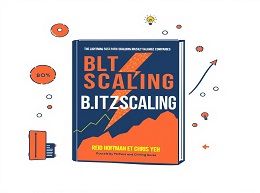Blitzscaling

Mastering Hypergrowth: A Deep Dive into "Blitzscaling"
In the ever-evolving landscape of business, achieving rapid growth is a dream for many entrepreneurs and executives. However, the path to hypergrowth is fraught with challenges and risks. Enter "Blitzscaling: The Lightning-Fast Path to Building Massively Valuable Companies" by Reid Hoffman and Chris Yeh. This book offers a comprehensive guide to scaling businesses at an unprecedented pace, leveraging insights from some of the world's most successful companies. In this review, we explore the key concepts of "Blitzscaling," its practical applications, and why it’s a must-read for anyone looking to understand the dynamics of hypergrowth.
The Concept of Blitzscaling
Blitzscaling refers to the strategy of prioritizing speed over efficiency in an environment of uncertainty. It’s about rapidly scaling a company to serve a large market before competitors can catch up. This concept is particularly relevant in today’s tech-driven world, where being first to market can be a decisive advantage.
The Origins and Rationale
The term "blitzscaling" is inspired by the German military tactic "blitzkrieg," which emphasized speed and surprise to achieve quick victories. Similarly, in business, blitzscaling focuses on rapidly scaling operations to dominate the market. The rationale is that in certain industries, capturing market share quickly can lead to network effects and economies of scale that create a formidable barrier to entry for competitors.
Prioritizing Growth over Efficiency
One of the core tenets of blitzscaling is the deliberate trade-off between efficiency and growth. In the early stages of blitzscaling, companies often operate inefficiently to accelerate growth. This might mean hiring rapidly, spending aggressively on marketing, or launching products with minimal features to capture market share quickly.
Example: Amazon
Amazon’s early years are a prime example of prioritizing growth over efficiency. Founder Jeff Bezos focused on expanding the company’s product offerings and market reach, even at the cost of significant financial losses. This strategy paid off as Amazon became the dominant player in e-commerce, reaping the benefits of economies of scale and network effects.
Managing Uncertainty and Risk
Blitzscaling involves navigating high levels of uncertainty and risk. Companies must make decisions quickly, often with incomplete information. This requires a willingness to experiment, fail, and iterate rapidly.
Practical Insight: LinkedIn
LinkedIn, co-founded by Reid Hoffman, exemplifies this principle. The company frequently tested new features and business models, learning from failures and quickly pivoting when necessary. This agile approach enabled LinkedIn to grow its user base and develop a sustainable revenue model.
Scaling Organizational Structures
As companies blitzscale, they must adapt their organizational structures to support rapid growth. This often involves redefining roles, establishing new processes, and fostering a culture that can handle the pressures of hypergrowth.
Example: Airbnb
Airbnb’s journey from a small startup to a global giant involved significant changes in its organizational structure. The company implemented new management layers, streamlined decision-making processes, and invested in leadership development to maintain agility while scaling.
When to Blitzscale
Not every business is suited for blitzscaling. Hoffman and Yeh emphasize that blitzscaling is most appropriate in markets with massive potential, where capturing a significant share quickly can create a sustainable competitive advantage. It’s also crucial for companies with scalable business models that can handle rapid growth without collapsing under their weight.
Case Study: Facebook
Facebook’s decision to open its platform to third-party developers in 2007 is a textbook example of blitzscaling. By doing so, Facebook rapidly expanded its ecosystem, driving user engagement and growth. This strategic move solidified Facebook’s position as the leading social network, making it difficult for competitors to challenge its dominance.
The Stages of Blitzscaling
Hoffman and Yeh outline several stages of blitzscaling, each with distinct challenges and strategies:
1. Family Stage : The initial phase where a small, close-knit team focuses on building a viable product.
2. Tribe Stage : The company starts to grow its team and market presence, often requiring the introduction of formal processes.
3. Village Stage : Rapid expansion continues, necessitating the development of more sophisticated management structures.
4. City Stage : The company operates at a large scale, with extensive processes and hierarchical structures to manage complexity.
5. Nation Stage : The company becomes a global entity, requiring robust governance and strategies to sustain growth and innovation.
Practical Insight: Uber
Uber’s growth trajectory mirrors these stages. Initially a small team in San Francisco, Uber rapidly expanded to cities worldwide. Each stage of growth required new strategies, from scaling its workforce to navigating regulatory challenges, all while maintaining the agility to outpace competitors.
The Role of Leadership in Blitzscaling
Effective leadership is critical to successful blitzscaling. Leaders must balance the urgency of rapid growth with the need to build a sustainable, scalable organization. This involves making tough decisions, fostering a culture of innovation, and maintaining a clear vision amidst the chaos of hypergrowth.
Example: Google
Google’s founders, Larry Page and Sergey Brin, exemplify blitzscaling leadership. They fostered a culture of innovation and risk-taking, supported by strategic hires and acquisitions. This approach enabled Google to scale rapidly while continuously innovating and expanding its market reach.
Transforming Industries
Blitzscaling has the power to transform entire industries. Companies that successfully blitzscale often set new standards for speed, efficiency, and customer expectations, forcing competitors to adapt or risk obsolescence.
Example: Netflix
Netflix’s transition from a DVD rental service to a streaming giant exemplifies industry transformation through blitzscaling. By rapidly scaling its streaming services and investing heavily in original content, Netflix redefined the entertainment industry, compelling traditional media companies to innovate and compete in the digital space.
Challenges and Criticisms
Blitzscaling is not without its challenges and criticisms. The aggressive pursuit of growth can lead to operational inefficiencies, cultural clashes, and ethical dilemmas. Critics argue that blitzscaling prioritizes short-term gains over long-term sustainability, potentially leading to significant risks.
Practical Insight: WeWork
WeWork’s tumultuous journey highlights the potential pitfalls of blitzscaling. The company’s rapid expansion was fraught with financial mismanagement and cultural issues, ultimately leading to a dramatic valuation collapse and restructuring. This serves as a cautionary tale for the risks associated with unchecked hypergrowth.
The Essential Guide for Hypergrowth
"Blitzscaling" by Reid Hoffman and Chris Yeh offers a comprehensive and practical guide to achieving hypergrowth in today’s competitive business environment. By prioritizing speed over efficiency, managing uncertainty, and adapting organizational structures, companies can navigate the challenges of rapid scaling and seize market opportunities.













